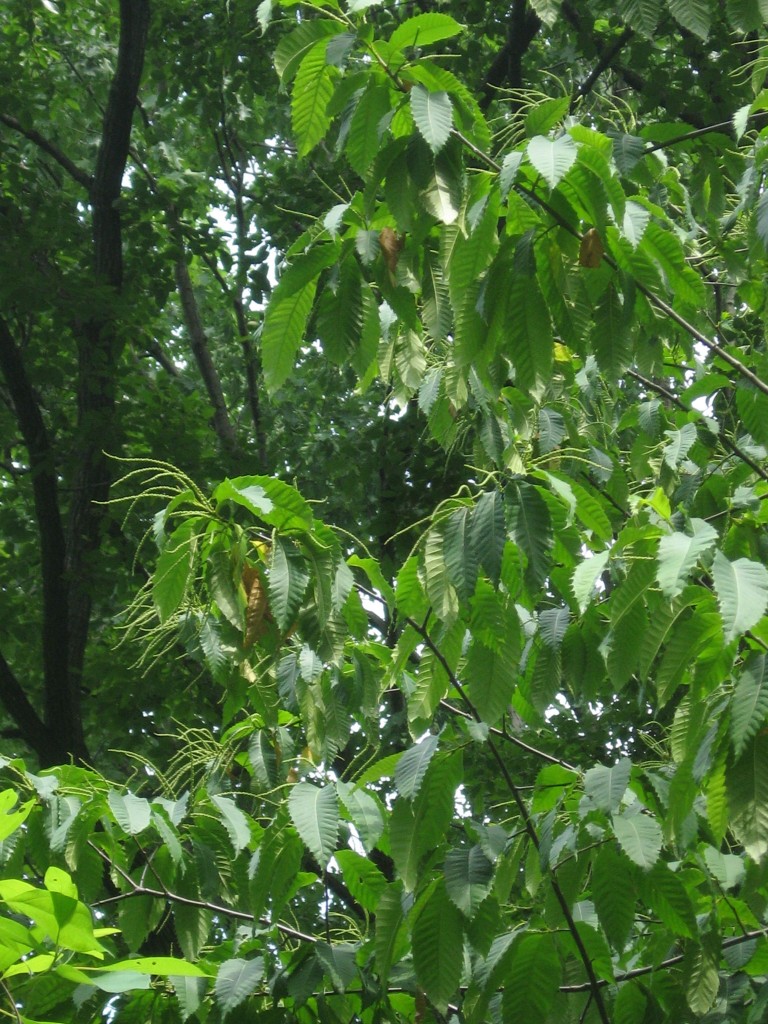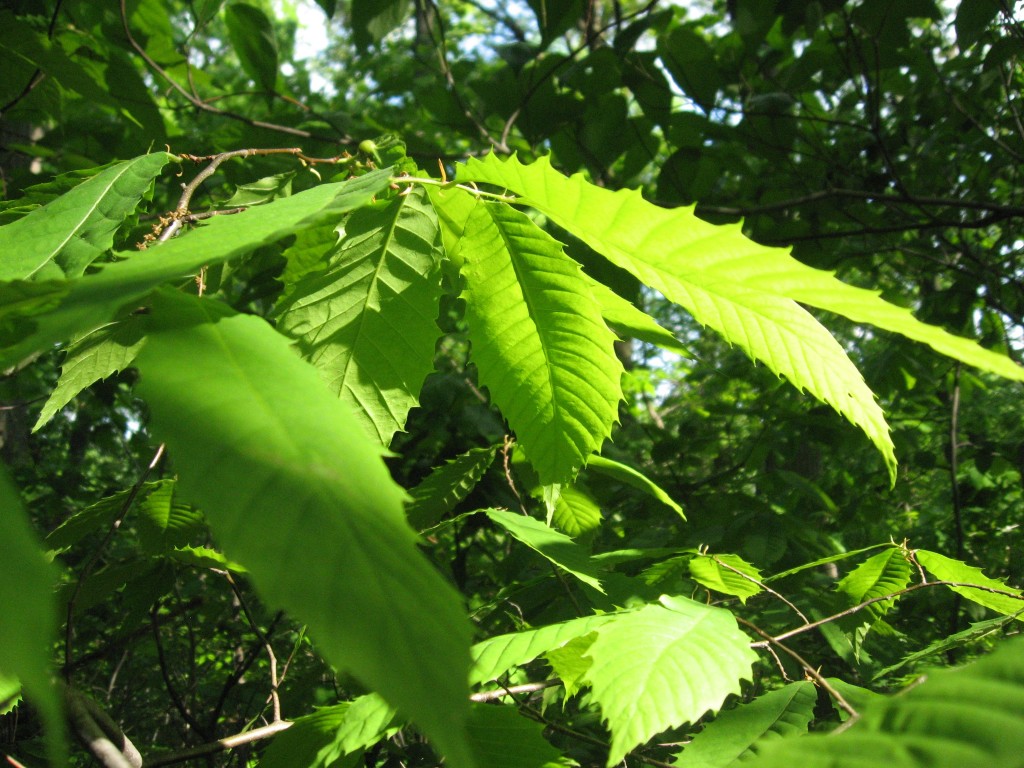ONE SPECIMEN Â OUT OF THE MANY CHESTNUT TREES IS BLOOMING RIGHT NOW IN MORRIS PARK

Just this one specimen is actually blooming. Â If there was one other in the vicinity blooming, then there could be viable seed in the fall. Â The tree is self-sterile, which means that there needs to be two separate trees blooming near each other that cross-pollinate in order or the seeds of each tree to be fertile, which means that they will germinate the next season and grow a new tree. Â However this is not the case. Â This blooming tree will not succeed in creating fertile seed in these conditions. Â We looked carefully among the many other Chestnut trees growing in the area for another one that was blooming and there were none. This may well be the only blooming Chestnut tree in all of Philadelphia.
Just to see this tree blooming is a rare sight, and we savored the view.  This is a tree that has become blighted and reduced from a canopy tree that covered the Eastern United States to a shrub that barely makes a presence on the forest floor.  The blight was brought in as an  introduced fungus on the Chinese Chestnut tree, imported to the Bronx Zoo in New York City in 1904.
The Chestnut Tree  was the tallest and most majestic tree in our forests.  It gave us the Chestnut, a sweet and nutritious nut (from the many written accounts), something that is now gone completely just 100 years after the initial introduction of the Chinese chestnut, which was carrying the deadly fungus, but is not affected by it.
The fungus that was growing on the Chinese chestnut was completely overlooked, yet the effects it has made on the entire forest of the Eastern United States is completely devastating. Â It ended up destroying billions of trees, and has brought the American forest into a state of disrepair.
The blight only kills the living tissue above the ground level. Â The roots are not affected and they continue to send out shoots, which become shrubs. Â And from time to time, these shrubs will bloom, as if they were the trees they once were.

Then there is the question of why do we care about having a Chestnut tree, here in West Philadelphia, produce a viable, fertile seed? Â To us, the Chestnut trees that still manage to grow here are still hundreds of years old. The ones that are now mere shrubs were once majestic canopy trees, with massive trunks, 6 feet in diameter. Â To have these same trees create seeds and if these seeds grew into new trees, then these new trees would represent the original genetic pool of the trees that grew and still grow in this very area and region for thousands of years. Â Someday if a disease resistant strain could be created, then there would be the option of breeding a’ Philadelphia’ tree with the newly developed one, and the local provenance of the tree could potentially live on into the future. It is important to keep a species alive, it is also important for any given area to keep a local population of that species alive. Â This local population has adapted the best to that area, whereas specimens from an introduced population may not be as hardy or adapted to the specific conditions of the locality, and they may wither away in the long term. Â Or they may become invasive.
When we saw the blooming catkins of Castanea dentata, the American chestnut tree here in Morris Park, we felt a bit of what it was like just 300 years ago, right here in this area of what we now call Morris Park, Philadelphia.  This blooming tree, for the most part reduced to a shrub status as a species is doing what it has been doing for the many thousands of  years before our time.



🙂 🙂 🙂
Have you read Richard Powers The Overstory?
Your article is interesting and encouraging as well. I came to it by using the link at the photo of the American Chestnut shrub taken Sunday, February 10, 2013 in Morris Park. I was interested in requesting a one-time use of it in the March & April 2022 issue of Fruit Gardener magazine, which will feature part 1 of a 2-part article on all chestnuts but beginning with the American Chestnut and its terrible fate. The reason is that I wanted to illustrate how the root systems live on and attempt to produce nuts, sometimes successfully. This image (image9.jpg) is an excellent example. Would you consider giving the California Rare Fruit Growers permission to use it? If so, please tell me at your earliest convenience how you would prefer for the photo credit to read. Ron Couch, editor
Hoping for a full account… as a long time lover of the the American Chestnut… and maybe the first one to note all those root saplings back in 2003-4.
I sent them a leaf and they confirmed that it was Castanea dentata, & not Chinese Chestnut mix, but there were no blooming trees then, & they didn’t indicate at the time that they were interested in seeds. Not sure they would be fertile if only one in bloom at a time. That was in 2004 or 5.
I am not exactly sure, but from what Beatriz is saying is that perhaps the blooming trees in Morris park could be pollinated with the pollen from other blooming chestnut trees. This human induced action could then create a set of results being 1: to create a fertile seed, using pollen from a different tree, being that these trees are self sterile. 2: these seeds would ideally be pollinated from a blooming specimen as close as possible in locality, assuring a genetic provenance as that is specific to this area, which would create a specimen that is well suited to the conditions of this area, whereas a specimen with genetic material from far to the north or south could not be suited to the environmental conditions of Philadelphia and will ultimately fail in the long term, especially with global warming throwing in another variable.
However, none of these actions insure a more disease resistant offspring, but the idea, Jacob and Beatriz, of maintaining contact with the Chestnut Foundation is a good one. Common intuition for what its worth indicates that the more cross pollination that occurs between geographically separate populations, the more likely a disease resistant strain will occur. One of the biggest mistakes of the reaction to the chestnut blight was to cut down every tree possible. If these trees were allowed to either die or possibly live, even if severely compromised, than perhaps there could have been enough genetic material being exchanged to result in disease resistant strains, naturally. However, from our experience, it is not too late. Pretty much every where we travel within its original range we find castenea dentata specimens, some are blooming. It is very possible that human intervention could revive this species without the need for any genetic material from the Chinese Chestnut. This assessment is completely unscientific, but it is worth thinking about. Thanks for the interest and involvement in this issue, and your thoughtful comments. Please, let us keep this conversation alive!
There will be an American chestnut workshop on March 9 sponsored by the Delaware native plant society at the Abbott’s Mill Nature Center. I plan to attend.
https://www.facebook.com/photo.php?fbid=423091134445948&set=a.114842208604177.27623.114294605325604&type=1&theater
Beatriz, thank you so much for letting us know. We have signed up and hope to meet you there! See you on Saturday.
This is two years late. But, did you get in touch with the American Chestnut Foundation? They need trees like this to pollinate them and increase the biodiversity of their blight-resistant crosses.
http://www.acf.org/field_guide.php
Beatriz, What a great idea! There is one more tree that may bloom this spring, and if it does, we will contact them.
As the last of the mature trees died, they were harvested for lumber. The wood is beautiful, strong, workable. They were marketed as ‘wormy chestnut’… all the rage in the early and mid-fifties. Old structures were salvaged and the lumber used for the same purpose. http://www.appalachianwoods.com/lumber/wormy_chestnut_lumber.htm?gclid=CPztzs_FrLUCFUqf4AodQVkADg
Jacob, sometimes Chestnut wood can be found in old late 19th century houses in Philly when it was used to mimic oak, which it resembles. The whole problem with the loss of the American Chestnut is attributed to the introduction of a foreign species the Chinese Chestnut, which brought along with it the fungus that destroyed the native tree. If all of the most basic common sense arguments against this practice do not resonate with those who see no problems in introduced species, than maybe the billions of dollars in economic loss due to the blight may sit well.
My chestnut tree has blooms also here in Monson. This is the 2d year, so maybe there is another nearby that we haven’t noticed that is fertilizing it. Oddly, the blooms appear to be on the branches that we thought were dead. It needs a professional examination.
From what we have observed, blooming is not related to cross-pollination. Yet cross-pollination is crucial to having fertile seed in a species where individual specimens are self-sterile, such as Castanea dentata. However, the fact that your tree is blooming is significant, and it is important to note that there are hundreds of centuries-old but blighted specimens of American chestnut on your property, as confirmed by the Sanguine Root. However none of these specimens had produced fruit. Because there were no other blooming specimens of Chestnut trees nearby, it is unlikely that your tree produced viable seed.
The story of the American Chestnut is indeed shocking and should be a warning call to the dangers of introduced species into our ancient forests. What will our forests look like in another 100 years, in 2111?
We at the Sanguine Root would like to be the people who are among the many others trying to make the forest healthy again in 2011.
I like this article! It is short and tightly focused on one of the denizens of the forest–a nice simple appreciation piece for the chestnut. I found that it gave me a renewed shock at what I once theoretically knew–that all our forests changed nearly overnight when this blight struck. Forests are not so very tranquil in a longer time frame–death and destruction is happening on a massive scale as inadvertent errors of importation occur, with consequences so far reaching….and frightening in their result.
Thanks for the insightful reminder, Root Team!